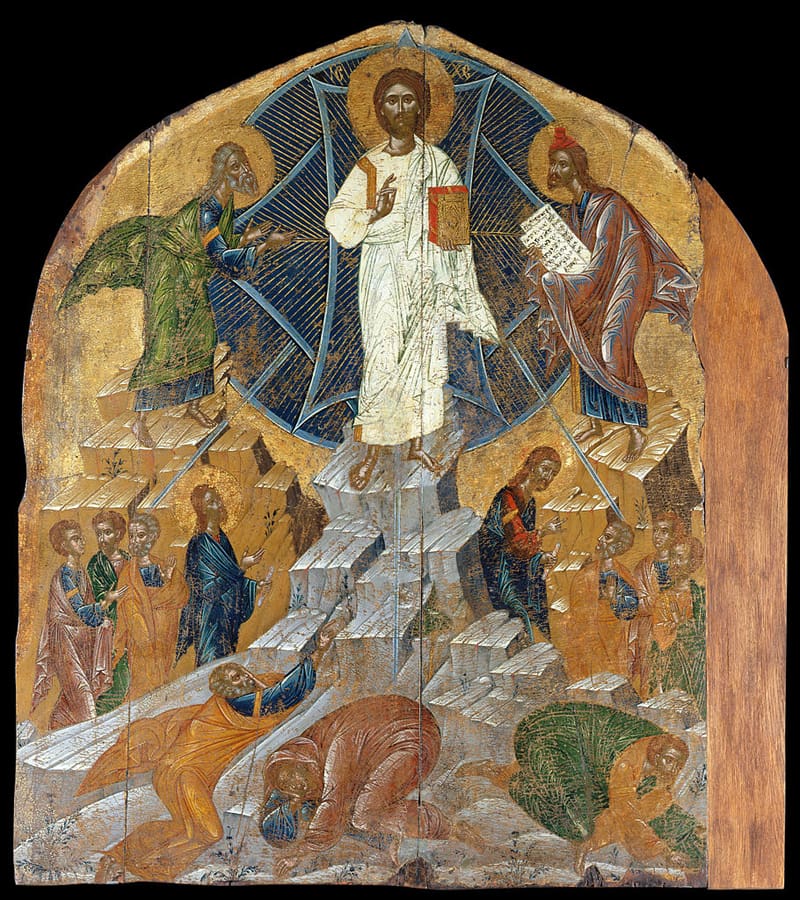
February 14, 2021
Revised Common Lectionary
2 Kings 2:1-12
Psalm 50:1-6
2 Corinthians 4:3-6
Mark 9:2-9
Lectionary for Mass (RC)
Leviticus 13:1-2, 44-46
Psalm 32:1-2, 5, 11 (7)
1 Corinthians 10:31 – 11:1
Mark 1:40-45
I’ve always loved to read. When I was a child, however, I was often oblivious to my surroundings, and so my mother would sometimes find me in a dimly lit room with my nose in a book. On those occasions she would usually flip on the light switch and offer a short but firm suggestion: “Throw a little light on the subject!”
Peter, James, and John had a similar experience as they saw Jesus transfigured before them. Peter had just six days earlier made his famous confession that Jesus was the Messiah (Mk 8:29), yet in the next breath he rejected Jesus’ teaching that he would suffer, die, and rise (8:31-32). Not only was he oblivious to the true nature of Jesus’ messiahship, but he was also clearly not ready to hear the corollary that being a disciple meant taking up his cross as well (8:34).
This lack of understanding provides the context for the experience that the three disciples had of seeing Jesus transfigured on the mountain (9:1 ff.). It was as though a switch had been flipped on and they could suddenly see Jesus in a whole new light.
Seeing, of course, does not necessarily imply understanding. Significantly, in Mark’s account of this event, the disciples’ response to seeing the glory of God in this image of Jesus transfigured was neither joy nor wonder, but terror (9:6)—the same reaction that the women had on the third day after the death of Jesus when they came upon the empty tomb and there encountered a young man dressed in white (16:8).
The vision given to Peter, James, and John—terrifying and puzzling—is something that they could never unsee even if they couldn’t quite comprehend it. They were changed by this experience but could not begin to appreciate the real meaning of this event until after Jesus had died and risen. Surely this was the reason that he ordered them to keep it to themselves “until after the Son of Man had risen from the dead” (9:9). The Gospel writer suggests that this instruction only compounded their confusion, making them question what “rising from the dead” could mean (1:10).
In the story we hear today, Jesus was transfigured but remained unchanged. It was the disciples who were changed as they looked upon “the glory of Christ, who is the image of God” (2 Cor 4:4). To them was given “the light of the knowledge of the glory of God in the face of Jesus Christ” (2 Cor 4:6). This “wondrous sight” was a preview of the glory that would ultimately be revealed through his suffering, death, and resurrection.
For churches that follow the Revised Common Lectionary, today’s celebration marks a pivot point between Epiphany and Lent. It brings the Epiphany season to a conclusion as we remember the manifestation of Christ’s glory to the three disciples on the mountain. At the same time, this story is an appropriate prelude to the Lenten journey that will begin on Ash Wednesday, forty days of preparation that conclude with the celebration of Christ’s suffering, death, and resurrection. The Transfiguration is for us a foretaste of the glory that we will celebrate at Easter, but only by way of the cross. Roman Catholics will hear this same Gospel story in two weeks, also offering a glimpse of Christ’s risen glory shortly after the beginning of Lent.
In the midst of illness, injustice, and personal struggles, it may be difficult to rejoice in or even notice the divine presence in our midst. Today’s Gospel is a call to hope, a proclamation that the crucified and risen One is indeed revealed among us. He has shown us that suffering, death, and new life are inseparably bound, and he invites us to join him on that road. May that vision remain with us and accompany us as we begin the Lenten journey this week.
A Hymn for Today: “Jesus, Take Us to the Mountain”
This text was written in 1991 by Slovak American Lutheran hymnwriter Jaroslav J. Vajda, FHS, in celebration of the fiftieth anniversary of St. Luke Evangelical Lutheran Church in Silver Spring, Maryland. The church also commissioned an original hymn tune, SILVER SPRING, composed by Carl Schalk.
Vajda has created a rich text that connects the Transfiguration both to the mystery of the Incarnation and to the Paschal Mystery of Christ’s death and resurrection, and so it is very appropriate for this Sunday that marks the turning point from Christmas-Epiphany to Lent-Easter.
Jesus, take us to the mountain,
where, with Peter, James, and John,
we are dazzled by your glory,
light as blinding as the sun.
There prepare us for the night
by the vision of that sight.
What do you want us to see there,
that your close companions saw?
Your divinity revealed there
fills us with the selfsame awe.
Clothed in flesh like ours you go,
matched to meet our deadliest foe.
What do you want us to hear there,
that your dear disciples heard?
Once again the voice from heaven
says of the Incarnate Word,
“Listen, listen, everyone:
this is my beloved Son.”
Take us to that other mountain
where we see you glorified,
where you shouted, “It is finished!”
where for all the world you died.
Hear the stunned centurion:
“Truly this was God’s own Son!”
We who have beheld your glory,
risen and ascended Lord,
cannot help but tell the story,
all that we have seen and heard;
say with Peter, James, and John:
“You are God’s beloved Son!”
Text: Jaroslav J. Vajda, 1991. © Concordia Publishing House. Used by permission under OneLicense #A-729857.
Tunes: SILVER SPRING, UNSER HERRSCHER
Image: Transfiguration of Christ
 “Word and Song: A Lectionary Reflection” is written by the Executive Director of The Hymn Society, Rev. Dr. Mike McMahon. For his full bio, click here and scroll down to the “staff” section.
“Word and Song: A Lectionary Reflection” is written by the Executive Director of The Hymn Society, Rev. Dr. Mike McMahon. For his full bio, click here and scroll down to the “staff” section.
